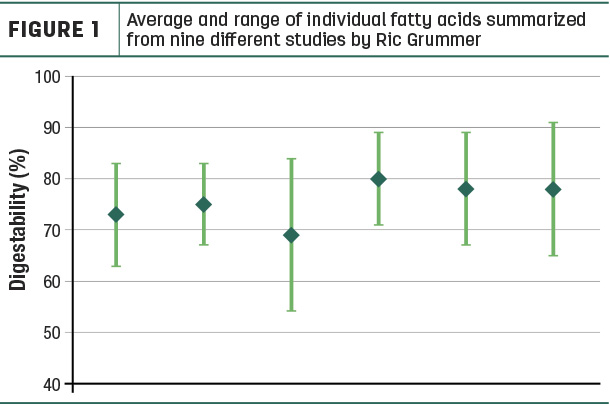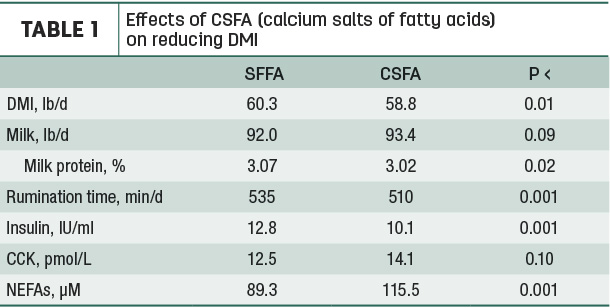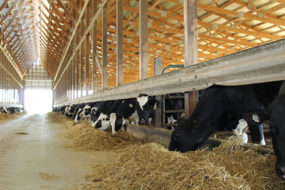Why are fat supplements fed? Because in early lactation, cows cannot eat enough to meet their increasing milk production energy requirements. Thus, cows go into negative energy balance. This is an issue for especially the first one-third of a lactation. And, this negative energy balance is more pronounced and for a longer period of time for cows beyond their first lactation. Consequently, fat supplements are used to increase energy density of the ration. But, if a fat supplement decreases dry matter intake (DMI), the benefit of using it is decreased.
Granted, the fat supplement must be digestible, too, but if it is a free fatty acid (FFA) product and not a high-melting-point triglyceride, that is a secondary question if the FFA is mainly palmitic (C16:0), stearic (C18:0) and oleic (C18:1). In 1999, Ric Grummer of the University of Wisconsin summarized data from six studies and graphed the results of each, which showed the wide variation in digestibility of individual fatty acids (FAs) (Figure 1). Note that stearic had the lower average and greater range. This is because if stearic is contained in triglycerides with a high melting point, it has a lower digestibility versus if it is present an FFA. Otherwise, there was little digestibility difference among these FAs.

So, what do we know about why some fat supplements decrease DMI? One simple factor is cows do not like greasy feed. An Illinois study found that tallow added to a ration had the most negative effect on intake when it was spread throughout the entire total mixed ration (TMR) rather than only on the haylage or only within the concentrate. That was a factor in why calcium salts of fatty acids (CSFA) were developed to make a dry, flowable fat source. In fact, Don Palmquist, who did this pioneering work in the U.S., told me the first CSFA they made was with tallow. But, because of lower cost, they then used a palm fatty acid distillate (PFAD) instead. In 2000, Mike Allen at Michigan State did an extensive review of published studies and found CSFA-fed rations decreased DMI. The National Research Council in 2001 formulated this relationship as, “Calcium salts of fatty acids [CSFA] decreased DMI by 2.5 percent for each percentage unit in the diet above the control …. Added hydrogenated fatty acids and triglyceride did not decrease DMI.”
This led to the question: Why or how do CSFA reduce DMI? In 2005, Mike Allen and then graduate student Kevin Harvatine did a study to help answer this question. They used high-producing mid-lactation cows for a two-week period and highly monitored and sampled them (Table 1).

At first glance, it looks like the CSFA had increased feed efficiency over the mostly saturated FFA because, while DMI decreased for cows on this treatment, they maintained milk production. How was this possible? The answer lies in looking at all the data. Note that cows fed CSFA had decreased blood insulin associated with their lower DMI, some numerical increase in the gut hormone cholecystokinin (CCK) and a somewhat surprising increase in non-esterified fatty acids (NEFAs), which are released into the blood stream when cows mobilize body condition. Thus, these cows were able to maintain milk production over this short time period when DMI decreased by mobilizing body condition. When CCK is released in the small intestine as some unsaturated FFAs escape biohydrogenation in the rumen, this causes the nerve that controls rumination to reduce rumination time, and this in turn results in lower DMI. All these actions are related to the increased dietary level of unsaturated FA. It is not due to the CSFA per se, but because most CSFA use unsaturated FA sources. While some may believe that calcium salts protect unsaturated FA from ruminal biohydrogenation (i.e., conversion to saturated FA), a review has found that about 85% of unsaturated FA are biohydrogenated in the rumen to saturated FA. Other studies have also observed the effect of higher levels of unsaturated FA on reducing DMI through the same metabolic mechanism.
Thus, the key to not having DMI decreases in dairy cows when utilizing a fat supplement is to use fat sources that are high in saturated FFAs. But, there is a more recent caveat to this recommendation. High levels of palmitic (greater than 80%) have been found to decrease DMI. A review of palmitic treatments versus non-fat controls in various studies yielded negative DMI from high-palmitic supplementation nine times, positive DMI four times and no effect on DMI six times. There are also two Penn State studies that showed negative effects on DMI with high-palmitic supplementation. In addition, this review found an average DMI decrease of 1.2 pounds per cow daily for palmitic versus non-fat control. At the May 2019 ADSA Discover Conference, a question was raised as to whether decreased DMI with CSFA (most commonly using PFAD) might be due to linoleic, palmitoleic or palmitic levels. As high-palmitic supplements also decrease DMI, maybe the decreased DMI with CSFA is also due to the higher palmitic FA content in PFAD? A study by West Virginia and Michigan State universities found that higher palmitic may increase ceramide formation and affect insulin, and these may be related to mechanisms for high palmitic decreasing DMI. Palmitic is a pre-cursor to ceramide synthesis.
A final consideration in a fat supplement is a recent finding that high levels (greater than 85%) of either palmitic or stearic showed evidence of crystalline formation, which could reduce digestibility. When these two FAs were blended, the melting point was also considerably reduced from 165ºF for stearic and 154ºF for palmitic to 142ºF for a blend of palmitic and stearic. Thus, a blend of palmitic and stearic avoids negative physical effects of these FAs individually, avoids decreased DMI and provides the best and most thoroughly studied and reviewed nutritional fat supplemental package.






